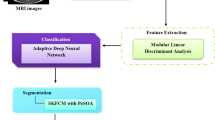Abstract
The primary objective of this paper is to develop a methodology for brain tumor segmentation. Nowadays, brain tumor recognition and fragmentation is one among the pivotal procedure in surgical and medication planning arrangements. It is difficult to segment the tumor area from MRI images due to inaccessibility of edge and appropriately visible boundaries. In this paper, a combination of Artificial Neural Network and Fuzzy K-means algorithm has been presented to segment the tumor locale. It contains four phases, (1) Noise evacuation (2) Attribute extraction and selection (3) Classification and (4) Segmentation. Initially, the procured image is denoised utilizing wiener filter, and then the significant GLCM attributes are extricated from the images. Then Deep Learning based classification has been performed to classify the abnormal images from the normal images. Finally, it is processed through the Fuzzy K-Means algorithm to segment the tumor region separately. This proposed segmentation approach has been verified on BRATS dataset and produces the accuracy of 94%, sensitivity of 98% specificity of 99%, Jaccard index of 96%. The overall accuracy of this proposed technique has been improved by 8% when compared with K-Nearest Neighbor methodology.






Similar content being viewed by others
Change history
04 April 2024
This article has been retracted. Please see the Retraction Notice for more detail: https://doi.org/10.1007/s11063-024-11601-4
References
Osareh A, Shadgar B (2011) A computer aided diagnosis system for breast cancer. IJCSI Int J Comput Sci 8(2):535–545
Sapra P, Singh R, Khurana S (2013) Brain tumor detection using neural network. Int J Sci Mod Eng (IJISME) 1(9):2319–6386
Dudoit S, Fridlyand J, Speed TP (2002) Comparison of discrimination methods for the classification of tumors using gene expression data. J Am Stat Assoc 97(457):77–87
Li L, Darden TA, Weinberg CR, Levine AJ, Pedersen LG (2001) Gene, assessment and sample classification for Gene expression data using a genetic algorithm and k-nearest neighbor method. Comb Chem High Throughput Screen 4(8):727–739
Khan J, Wei JS, Ringner M et al (2001) Classification and diagnostic prediction of cancers using gene expression profiling and artificial neural networks. Nat Med 7(673):679
Jong K, Mary J, Cornuejols A, Marchiori E, Sebag M (2004) Ensemble feature ranking. In: Proceedings of European conference on machine learning and principles and practice of knowledge discovery in databases
Acır N, Ozdamar O, Guzelis C (2006) Automatic classification of auditory brainstem responses using SVM-based feature selection algorithm for threshold detection. Eng Appl Artif Intell 19:209–218
Statnikov A, Aliferis CF, Tsamardinos I, Hardin D, Levy S (2005) A comprehensive evaluation of multicategory classification methods for microarray gene expression cancer diagnosis. Bioinformatics 21(5):631–643
Popuri K, Cobzas D, Murtha A, Jägersand M (2012) 3D variational brain tumor segmentation using Dirichlet priors on a clustered feature set. Int J Comput Assis Radiol Surg 7(4):493–506
Patil S, Udupi V (2012) Preprocessing to be considered for MR and CT images containing tumors. IOSR J Electr Electron Eng 1(4):54–57
Wu W, Chen AY, Zhao L, Corso JJ (2014) Brain tumor detection and segmentation in a CRF (conditional random felds) framework with pixel-pairwise afnity and superpixel-level features. Int J Comput Assis Radiol Surg 9(2):241–253
Chaddad A (2015) Automated feature extraction in brain tumor by magnetic resonance imaging using gaussian mixture models. Int J Biomed Imaging 2015:868031. https://doi.org/10.1155/2015/868031
Damodharan S, Raghavan D (2015) Combining tissue segmentation and neural network for brain tumor detection. IAJIT 12:1
Abbasi S, Tajeripour F (2017) Detection of brain tumor in 3D MRI images using local binary patterns and histogram orientation gradient. Neurocomputing 219:526–535
Ariyo O, Zhi-guang Q, Tian L (2017) Brain MR segmentation using a fusion of K-means and spatial fuzzy C-means. In: 2017 international conference on computer science and application engineering (CSAE 2017), pp 863–873
El Abbadi NK, Kadhim NE (2017) Brain cancer classifcation based on features and artifcial neural network. Brain 6:1
Sharif M, Tanvir U, Munir EU, Khan MA, Yasmin M (2018) Brain tumor segmentation and classification by improved binomial thresholding and multi-features selection. J Ambient Intell Humanized Comput. https://doi.org/10.1007/s12652-018-1075-x
Shubhangi N, Dudhane A, Murla S, Naidu S (2020) RescueNet: an unpaired GAN for brain tumor segmentation. Biomed Signal Process Control 55:101641
Saba T, Mohamed AS, Affendi M, Amin J, Sharif M (2020) Brain tumor detection using fusion of hand crafted and deep learning features. Cognit Syst Res 59:221–230
Amin J, Sharif M, Gul N, Yasmin M, AliShad S (2020) Brain tumor classification based on DWT fusion of MRI sequences using convolutional neural network. Pattern Recogn Lett 129:115–122
Deng W, Shi Q, Wang M, Zheng B, Ning N (2020) Deep learning-based HCNN and CRF-RRNN model for brain tumor segmentation. IEEE Access 8:26665–26675
Zhou C, Ding C, Wang X, Lu Z, Tao D (2020) One-pass multi-task networks with cross-task guided attention for brain tumor segmentation. IEEE Trans Image Process 29:4516–4529
Emami H, Derakhshan F (2015) Integrating fuzzy K-means, particle swarm optimization, and imperialist competitive algorithm for data clustering. Arab J Sci Eng 40(12):3545–3554
Chang C-T, Lai JZC, Jeng M-D (2011) A fuzzy K-means clustering algorithm using cluster center displacement. J Inf Sci Eng 27:995–1009
Author information
Authors and Affiliations
Corresponding author
Additional information
Publisher's Note
Springer Nature remains neutral with regard to jurisdictional claims in published maps and institutional affiliations.
This article has been retracted. Please see the retraction notice for more detail: https://doi.org/10.1007/s11063-024-11601-4
Rights and permissions
Springer Nature or its licensor (e.g. a society or other partner) holds exclusive rights to this article under a publishing agreement with the author(s) or other rightsholder(s); author self-archiving of the accepted manuscript version of this article is solely governed by the terms of such publishing agreement and applicable law.
About this article
Cite this article
Pitchai, R., Supraja, P., Victoria, A.H. et al. RETRACTED ARTICLE: Brain Tumor Segmentation Using Deep Learning and Fuzzy K-Means Clustering for Magnetic Resonance Images. Neural Process Lett 53, 2519–2532 (2021). https://doi.org/10.1007/s11063-020-10326-4
Published:
Issue Date:
DOI: https://doi.org/10.1007/s11063-020-10326-4




